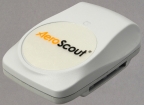AeroScout, a San Mateo, Calif., provider of a Wi-Fi-based RFID real-time location system, has begun a pilot project for international mining company Inco to track assets within a nickel mine in Sudbury, Ontario.
At the mine, which reaches a depth of 3,280 feet (1,000 meters), AeroScout attached its T2 active tags to an undisclosed number of mobile objects, such as vehicles, containers and drills. The tags operate at 2.4 GHz and have an indoor read range of 180 feet and an outdoor read range of 600 feet. Each tag weighs 1.2 ounces and is 2.44 inches by 1.57 inches by .67 inch. Protected from water and dirt through a hard plastic housing with rubber liner, the tags can be mounted onto a plate that is screwed onto an object, or mounted onto a wristband or onto Velcro.
Each tag can hold up to 100 bytes of data, but in the Inco pilot, the tags do not store data. Instead, each one broadcasts only its media access control (MAC) address (a unique 12-character number that is assigned to the tag during the manufacturing process) to the mine’s existing 802.11 wireless network of Cisco Wi-Fi access points. These access points then route each MAC address from the T2 tags to the AeroScout Engine software, which calculates the location of the asset by measuring the strength of the tag’s signal. The AeroScout Engine feeds this data into AeroScout MobileView software, which associates each MAC address with the asset to the corresponding tag is attached. The MobileView software also provides Inco staff with a view of the tagged assets on a map of the monitored areas within the mine.
Inco personnel will not comment on the pilot, but according to AeroScout, the pilot results have been positive, and likely, the system will be deployed permanently and more T2 tags will be put into use to track more assets. The ultimate goal of deploying the system is to be able to increase ore extraction productivity in the mine through more efficient tracking and management of the assets used in the extraction process.
According to AeroScout’s marketing manager, Joshua Slobin, the Cisco wireless access points that Inco uses have specialized casings to protect them from exposure to shock, moisture and dirt inside the mine. Slobin is not aware of any RF interference caused by the ore in the mine. He says the access points were able to read the T2 tags upon installation.
The mine currently uses no automated system to track assets underground other than the AeroScout system, but Slobin says the potential benefits of the Wi-Fi RFID system in the mine are not just its ability to track assets. The location system could also have safety applications, he says. If miners were assigned tags, the system could helpful in locating workers in the event of a serious accident, such as a mine collapse. The system could also be used to help ensure that specific zones within the mine were completely evacuated prior to a scheduled blast.


